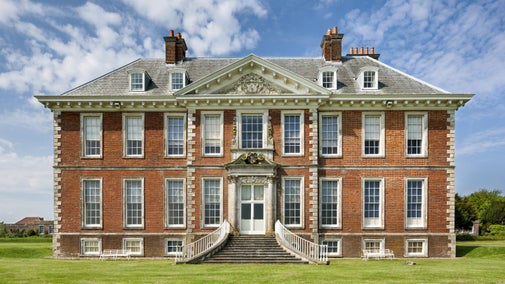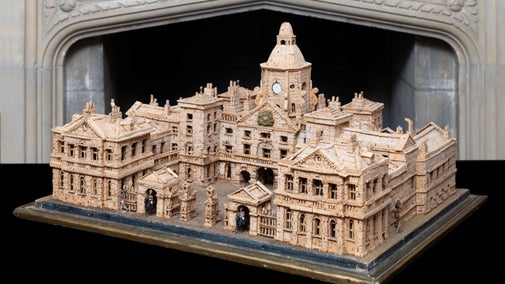
Uppark's collections
Explore the objects and works of art we care for at Uppark House and Garden on the National Trust Collections website.

The grand, Palladian-style 18th-century dolls' house at Uppark is among the most historically important in the country, and one of only a handful that have survived from the era in such good condition.
Our Doll's House can be viewed at the Huguenot Museum in Rochester.
It was originally made for the Lethieullier family and came to Uppark after Sarah Lethieullier married Sir Matthew Fetherstonhaugh in 1746. Although little information exists about the origins of the dolls' house, it is believed to have been made in the 1730s.
Built in the style of a Palladian mansion, the house features three floors topped by a balustrade and seven classical figures, with the Lethieullier coat of arms on the central pediment. It features four bedrooms, two reception rooms, and three rooms 'below stairs' for the servants.

Just like the house it now stands in, the dolls' house rooms are filled with delicate porcelain, imported silks, fine furniture and Flemish-style oil paintings. The chairs are richly carved from mahogany and ivory with silk and leather seat cushions, the furniture carries intricate inlays and real marble tops, the silverware is hallmarked, and the candles are real – the glass hoods suspended from the ceiling are to prevent smoke stains.
As a product of its time, there is a clear divide between those who lived upstairs and the servants below. The grandest furniture and finest decorations are reserved for the upstairs rooms, but the dolls themselves reveal an even clearer distinction. The lords and ladies are made from wax and dressed in fashionable fabrics trimmed with gold thread, whereas the servants are more robustly made from wood and wear far simpler clothing.

Some dolls' houses were created as extravagant playthings for young children, but the remarkable condition of Uppark's example, and the fact that the dolls do not have articulated limbs allowing them to be posed, means this is doubtful in this case.
Other 'baby houses' were intended as a teaching aid, perhaps to instruct a future lady of the house about the running of a large household. However, since many of the rooms required for this task are missing, particularly the service areas, this also seems unlikely.
A third possibility is that the house was an elaborate curiosity, an exquisitely detailed display of wealth and taste to be admired by Sarah Lethieullier and her friends.
It's not clear if it was bought as a whole or if its contents were added over time, making the acquisition of new items a pastime of its own. The copper pots and pans in the kitchen are out of scale with the rest of the house, possibly lending weight to this argument.
We know from extensive paint analysis that the exterior of the house has been repainted twice, while the interior has been partially repainted once. During construction, it seems a red-brick effect for the façade was trialled but quickly rejected in favour of a simple cream-coloured oil paint.
The statues on top of the pediment were originally covered in glazed silver leaf to achieve a silver-gilt effect, although this has long been lost in the subsequent redecorations. The present off-white paint is a lead-based formulation, which could have been applied any time before the 1940s. The Lethieullier coat of arms and the interior marbling to fireplaces and dining room niche are, however, original.

Explore the objects and works of art we care for at Uppark House and Garden on the National Trust Collections website.
Items from Uppark’s dolls’ house have undergone its biggest conservation project in decades. Discover how conservators cleaned and repaired the tiny textile pieces.

Take a look inside this classic historical house, filled with exquisite furnishings from all over the world, and discover what life was like below stairs for serving staff.

Uppark is a fine example of a 17th-century country house, crowning the South Downs ridge in West Sussex. Cherished by generations of families, Uppark has attracted a succession of colourful owners, residents and visitors including the Fetherstonhaugh family, Emma Hamilton and a young H.G. Wells.

Discover the stories behind some of the greatest artworks and artefacts looked after by the National Trust, as told in a dedicated book, 125 Treasures from the Collections of the National Trust.

See the breadth of our collection of works of art, furniture and more: we care for around a million objects at over 200 historic places, there’s a surprise discovery around every corner.

The art and heritage collections we care for rival the world’s greatest museums. Learn more about the collection of paintings, decorative art, costume, books, household and other objects at historic places.
